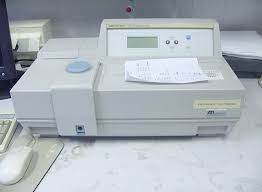Spectrophotometers are instruments that measure the properties of materials by using the electromagnetic spectrum. They measure the properties of a material as a function of wavelength. Spectrophotometers can be classified into single-beam and dual-beam models. Each type of spectrometer has specific applications.
Single-beam spectrophotometer
The single-beam spectrophotometer is an option for single wavelength spectra. These instruments offer a very high energy throughput and are very sensitive. These instruments are also relatively inexpensive compared to other types of spectrophotometers. However, they lack compensation for potential disturbances, which can include voltage fluctuations, electronic circuit fluctuations, or mechanical component instability. This may result in abnormal fluctuations in the results.
Single-beam spectrophotometers are less complicated than double-beam models, and have fewer moving parts. These spectrophotometers also tend to be more reliable than their double-beam counterparts. Modern devices also offer software for analysis and baseline correction. Single-beam spectrophotometer technology is also compact and portable, which means they are more convenient to use and store.
Single-beam spectrophotometers measure the concentration of analytes and organic compounds in a sample. They are also ideal for kinetic assays and can measure wavelengths up to 1100 nm. The spectrophotometer can also be used to measure dissolved oxygen content in water, respiratory gases, and even molecular weight of a compound.
A single-beam spectrophotometer consists of a single beam of light that passes through a biological sample holder. The wavelength is selected by a monochromator, which excludes the effects of solvent properties and other biological compounds. Single-beam spectrophotometers have good accuracy in wavelengths between 190 and 1100nm.
Spectrophotometers with two spectrometers
Spectrophotometers are devices that analyse the wavelengths of light. They typically contain a light source and a prism that separates the light into wavelengths. The light is then redirected through a wavelength selector and then to a photometer where it is detected. The photometer measures the number of photons absorbed and sends the result to a digital display.
These instruments are used in many applications that require precision and consistency. For example, car manufacturers must ensure the consistency of body colours and brands across all their marketing materials. They need precise measurements for these purposes, and spectrophotometers are essential in making sure they achieve these goals. While the human eye is very accurate in detecting colour differences, spectrophotometers can help minimise these differences and provide accurate readings in a matter of seconds.
Read Also : How To Choose the Right White Label SEO Package
Applications of spectrophotometers
A spectrophotometer is an instrument that can separate specific wavelengths from a source of light. It uses a prism, grating, or interference filter to accomplish this. Its basic layout is similar to that of a colorimeter. It is composed of an illuminant that projects light onto the sample and through a prism that isolates one specific wavelength band. The spectrophotometer then passes the data to a processor for analysis. Applications of spectrophotometers include measuring reflectance, transparency, illuminance, and tristimulus values.
Spectrophotometers are available in different types. There are scanning spectrophotometers and non-scanning spectrophotometers. Scanner spectrophotometers are better suited for determining the colour of an object, while non-scanning spectrophotometer are more accurate and faster. In-line Spectrophotometers is also quite popular in 2022
Spectrophotometer use UV or visible light to measure the absorbance of a sample. Typically, the sample is held in a cuvette, but some spectrophotometer let you pipet a sample directly onto the measurement area. Several other applications of spectrophotometer include determining DNA concentration and purity. Additionally, they can be used to measure protein concentrations.
Spectrophotometry is used in numerous fields, including the aerospace, chemical, oil, and gas industries. In the aerospace industry, it is used to identify the failures of structures and components. In addition, it can also identify the composition of paint systems and identify flaws in aluminium alloys.


















